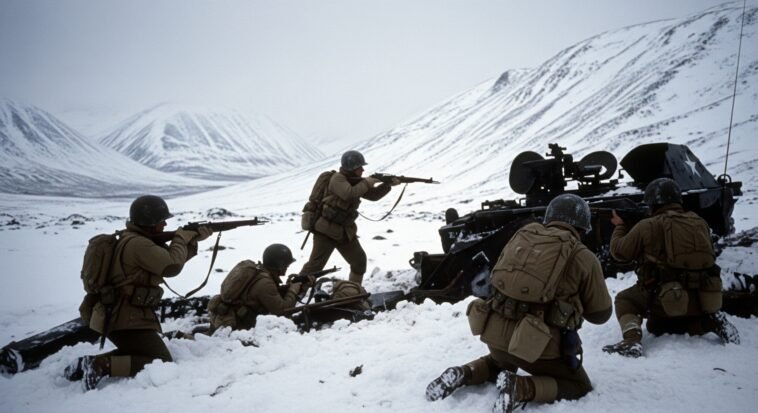
When we think WWII, we picture D-Day or the Pacific islands—not Alaska.
But from 1942 to 1943, U.S. and Canadian troops fought Japanese forces in the brutal Aleutian Islands.
Think freezing winds, nonstop fog, and rough mountain terrain—not exactly beach vibes.
This was the only WWII land battle on U.S. soil. It mattered, it was messy, and it’s mostly forgotten.
This piece dives into why the Aleutian Campaign was a big deal—and why no one talks about it.
The Strategic Gambit: Why Alaska Mattered
In June 1942, while everyone was focused on the famous Battle of Midway, Japan pulled a fast one and invaded Alaska’s Aleutian Islands.
For years, people argued about whether this move was just a distraction or something bigger. Turns out—it was both.
Here’s what Japan was thinking:
Protect their backyard
The Aleutians stretch over 1,000 miles toward Japan.
By taking them, Japan could block the U.S. from creeping up through the north and threatening their home turf.
Scare north America
Setting up bases on islands like Attu and Kiska gave Japan spots close enough to hit Alaska—or even parts of Canada and the U.S. West Coast.
Not great for morale.
Mess with U.S. shipping
Controlling the Aleutians meant Japan could screw with U.S. supply ships in the North Pacific. F
ewer supplies = more problems for the Allies.
For the U.S., this was a major slap in the face. A foreign army landing on American soil? That hadn’t happened since the War of 1812.
The U.S. wasn’t having it. The goal was clear: take back the islands, no matter what it cost.
Fun fact: Way before WWII, General Billy Mitchell predicted this. He said, “Whoever holds Alaska will hold the world.” Sounds dramatic, but he kinda nailed it.

- Read also: Understanding the Differences: World War I Vs World War II
- Read also: A Historical Overview: Major Battles of World War II
The Invasion: Attu and Kiska Under Japanese Control
On June 3, 1942, Japan bombed Dutch Harbor, a U.S. Navy base on Unalaska Island.
That strike kicked off the Aleutian Campaign. A few days later, Japanese troops landed on two U.S.-owned islands: Kiska (June 6) and Attu (June 7).
What followed was messy, cold, and tragic—and most people don’t even know it happened.
Kiska: The quiet takeover
There wasn’t much resistance when Japan hit Kiska. A tiny U.S. weather station was there, run by just 12 guys. Most of them got captured fast.
But one man, Chief Petty Officer William C. House, pulled a real-life survival movie—he hid for 50 days in the freezing wilderness before giving up due to hunger and cold.
Japan set up shop quickly. They dropped in thousands of soldiers—over 7,000 by the end—and started building airstrips, bunkers, and heavy defenses.
They were digging in for a long stay.
Attu: No army, just civilians
Attu was even more remote.
Japan landed about 1,100 troops and found no military—just a small group of Unangax̂ (Aleut) natives and two Americans: Etta and Fred Jones. Fred was a radio operator.
He refused to help fix a Japanese radio, so they shot him. One local Unangax̂ man was also killed.
The rest of the island’s 42 Unangax̂ residents were taken prisoner—the only American civilians captured by Japan in WWII.
The Japanese shipped them off to Hokkaido, Japan, where they were thrown into horrible camps. Nearly half of them died from disease, hunger, or abuse.
Meanwhile, the U.S. government also relocated many other Aleutian communities “for their safety” but dumped them in filthy, cold camps with barely any food.
Lots of people got sick. Many died. That part of the war rarely gets talked about—but it should.
Life under Japanese control was brutal for everyone
The weather was a killer
Fog. Freezing rain. Wind strong enough to flip planes. Soldiers on both sides got frostbite, trench foot, or worse—just from being outside.
The Japanese dug in
They weren’t just chilling on the islands.
They started building deep tunnels, hiding artillery, and covering the land in mines—ready for the U.S. to strike back.
Supplies? what supplies?
Getting food and gear to such remote islands was a nightmare for Japan.
Once the U.S. Navy cut off supply lines, things got worse fast for the Japanese troops stuck there.

The Bloody Recapture: The Battle of Attu
After months of bombing and cutting off supplies, the U.S. made its move.
The target: Attu, the smaller and more isolated island, defended by about 2,600 Japanese troops.
The plan? Operation Landcrab. It kicked off on May 11, 1943.
The battle that followed was one of the ugliest fights in the whole Pacific War.
Key aspects of the battle of Attu:
The weather was the real boss fight
Forget palm trees—this was ice, wind, fog, and mud. Troops froze in place.
Frostbite and trench foot took out more guys than bullets. Planes couldn’t see. Ships couldn’t help. It was a mess.
The Japanese fought to the end
Colonel Yasuyo Yamasaki and his men weren’t giving up. They were dug in—snipers in foxholes, surprise attacks from the hills. No one expected it to be this brutal.
May 29: The final banzai charge
With defeat closing in, Yamasaki threw everything into one last charge—over 1,000 men charging straight at U.S. lines in a full-on suicide attack.
It worked—for a moment.
They broke through and started hand-to-hand fighting at Engineer Hill, but U.S. engineers, cooks, and medics grabbed weapons and pushed them back.
Almost every Japanese soldier died, including Yamasaki.
The numbers hurt
Only 28 Japanese soldiers survived. On the U.S. side:
- 549 killed
- 1,148 wounded
- 1,800+ taken out by frostbite, infections, and illness
Per soldier involved, Attu was the second deadliest Pacific battle, just behind Iwo Jima.
The Ghostly Landing: The Kiska Deception
After the brutal win at Attu, the U.S. and Canada turned to Kiska, expecting an even nastier fight.
Intelligence said over 10,000 Japanese troops were dug in. So the Allies went big—Operation Cottage launched on August 15, 1943, with 35,000 U.S. troops, 5,000 Canadians, warships, and planes all ready for battle.
And then… crickets.
Plot twist: The enemy was gone
While everyone was prepping for a bloodbath, Japan had already dipped.
Operation KE: The great escape
Between July 28–30, using the thick Aleutian fog as cover, the Japanese Navy snuck into Kiska Harbor.
Two cruisers and six destroyers pulled off a clean sweep—5,183 troops evacuated in 55 minutes.
Not a single Allied plane or ship caught them. Just… gone.
And then came the awkward part
The Allies landed, expecting chaos. Instead, they walked into an empty island.
But it wasn’t bloodless.
Friendly fire fiasco
In the thick fog and confusion, troops started shooting each other, thinking the enemy was still hiding out.
Over 100 soldiers were killed or wounded by friendly fire.
Booby traps & a deadly mine
Some troops died from leftover Japanese traps. And the destroyer USS Abner Read hit a mine—71 sailors died.

The Legacy of the “Thousand-Mile War”
The Aleutian Islands Campaign wrapped up in August 1943 after the Allies reoccupied Kiska.
Most people barely remember it—but they should. Here’s why it mattered:
1. The only time WWII hit U.S. soil
Yep, Japan actually took land in North America.
Attu and Kiska weren’t just random islands—they were occupied U.S. territory. That made this campaign personal.
2. Training ground for bigger battles
Fighting in freezing weather, stormy seas, and brutal terrain taught the U.S. military a lot—like how to handle amphibious landings and deal with enemies who refused to quit.
These lessons helped in later Pacific island battles.
3. People paid the price
Thousands of troops died—not just from bullets, but from the cold, disease, and accidents. And let’s not forget the Unangax̂ people—many were taken prisoner or forced into terrible camps.
Half of the Attu villagers died. That story often gets ignored.
4. Alaska changed for good
The military built airfields, roads, and ports all over Alaska during the campaign.
That stuff stuck around and helped the state grow after the war.
5. Still forgotten
Even with all that, the Aleutians barely get mentioned in history books. Maybe because it was so remote.
Maybe because Midway and Europe got all the headlines. But the sacrifice was real.
- Read also: Why Japan Really Attacked Pearl Harbor: The Historical Analysis
- Read also: The Cold War’s Weirdest Spy Gadgets: A Peek into Espionage Ingenuity
Final Thought: Don’t Forget Alaska’s WWII Heroes
The Aleutian Campaign wasn’t flashy. No huge headlines, no big movie scenes.
But the soldiers who fought there—on frozen islands like Attu and Kiska—faced brutal cold, zero visibility, and a stubborn enemy.
Many didn’t make it. Some never fired a shot before the land itself took them down.
This campaign was rough, real, and seriously overlooked.
By telling their stories, we do more than fill a history gap—we give credit where it’s long overdue.
These weren’t background players. They fought in one of the harshest places on earth to defend home turf. That matters.
So next time someone brings up WWII, toss Alaska into the convo. Let’s not leave these heroes buried in the fog.



